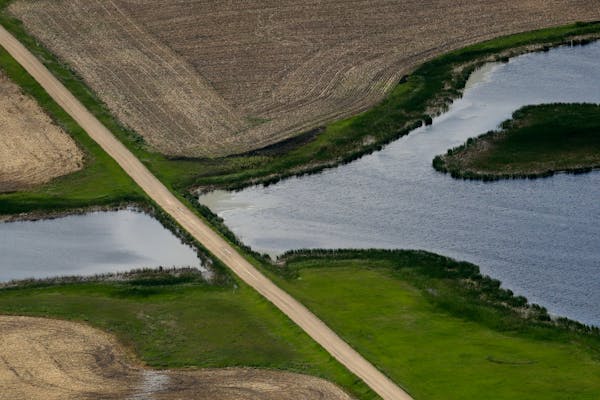An effort to turn hundreds of acres of Minnesota farmland back into the wetland it once was has turned into a fight over whether the project should be eligible for tens of millions of dollars in environmental mitigation credits.
At 617 acres, the Mille Lacs Meadows North Wetland Bank in Aitkin County would be one of the largest restored wetlands in Minnesota's robust offset credit system for keeping the state's wetland acreage stable.
The Aitkin County wetlands were drained away over many decades for farming. For the land to be eligible to generate $40 million in replacement wetland credits, the ditches had to either have been dug before the state's Wetland Conservation Act (WCA) took effect in 1991 or had to have been exempted or somehow mitigated. The credits can be sold to farmers and developers impacting wetlands elsewhere, offsetting those losses.
Local officials determined the Aitkin County land was eligible.
Opponents have appealed Aitkin County's approval of the large project, arguing that a significant portion of the land was illegally ditched and drained after the act took effect and without mitigation, making the land ineligible to generate the approved 433 credits. The former landowner vehemently denies that.
In an appeal letter last month to the state Board of Water and Soil Resources, Minneapolis lawyer Bryan Huntington, representing a coalition of environmentalists and "stakeholders in the wetland banking system," wrote that the Mille Lacs Meadows North project "is in direct conflict with the WCA's primary purpose." Huntington alleged that it was drained after the law took effect without any type of mitigation, exemption or credit buying, and that should make it ineligible to generate credits now.
The opponents also raised concerns about potential bias and a conflict of interest. The state Board of Water and Soil Resources, the top wetland regulator, confirmed it is in line to buy 13.5 credits and its former wetland credit program coordinator went to work for the developer, the Baltimore-based private equity firm Ecosystem Investment Partners.
Under the act, most drained wetlands that are impacted by development including road widening, new housing or farming have to be replaced in an equal amount. Farmers, developers and landowners often offset those losses by purchasing mitigation credits from refurbished wetlands elsewhere. The credits are preferably bought from wetlands in the same area as the ones destroyed, typically one credit per acre.
Driven by urban development in a service area that includes the city of St. Cloud, credits in central Minnesota average about $99,000 per acre — far more than in other parts of the state.
The area in dispute was historically mapped as "Conifer Bogs and Swamps" before European settlers came and started farming it, according to the project application. Key evidence in the appeal are aerial photographs, available on Google Earth, and an analysis of the land's drainage history by a civil engineering firm.
Images from 2003 show pronounced criss-cross ditches on part of the land that do not appear to exist in older photos before the 1991 WCA took effect. The analysis for the appeal looked at an earlier ditching study done for the landowner, and it concluded there were "little or no constructed manmade drainage features" on the land prior to 1991.
The environmental group first raised its objections with Aitkin County at the start of the project last year in a letter. Aitkin County Wetland Specialist and compliance officer Henry Egland said the county disagreed with the opponents. The previous landowner cooperated and worked closely with regulators, Egland said.
Mohamed Nouri agreed. He's the Minneapolis businessman who owned the Aitkin County land for decades. In an interview, Nouri called himself an environmentalist and strongly denied doing anything wrong. The 4,500 acres he bought just north of Lake Mille Lacs in 1993 had already been heavily ditched and plowed by generations of previous farmers, he said.
"To the best of my knowledge all the government rules were followed," Nouri said.
The controversy all dates to around 2011, when concerns about potential ditching violations first arose. They were investigated by state and federal agencies as well as a local "technical evaluation panel" that makes the state's final wetlands call. There were no resulting violations. However, Nouri said the federal Natural Resources Conservation Service found a "small" violation whose details he couldn't recall but that it was addressed. That agency doesn't confirm individual investigations or enforcement actions.
The local panel driving the state's investigation took the matter very seriously, said Steve Hughes, the former district manager of the Aitkin County Soil and Water Conservation District,who headed the panel. They considered a restoration order, Hughes said, but with all the ditches that had been dug "it wasn't clear that there was a violation."
Hughes said repeatedly that people cannot rely on aerial photographs to see ditching but need to walk the land. Ditches can become overgrown and obscured by vegetation. That's what he thinks likely happened in this case — that old ditches that existed prior to 1991 were obscured by vegetation that was later cleaned out. It's legal to clean vegetation out of existing ditches, he noted.
Hughes, who retired, now works with Nouri marketing other parts of Nouri's land. That's no different than working with anyone else in the area, he said, given that he worked with nearly everyone in the rural county in some fashion over his 40-year career.
Nouri built a strong case for himself during the investigations, the records show. He had a lawyer, hired an engineering firm for a drainage history and provided affidavits from his farm manager and others about the long history of families farming and digging ditches to drain the land back to 1900.
It all culminated in a 2015 agreement in which Nouri agreed to follow some best management practices such as using buffers and conservation tillage to reduce erosion.
Nouri now works for a medical device company he founded called Medspira. He said he was just looking for a lake cabin back in the 1990s when he wound up buying 4,500 acres in Aitkin County. He started Mille Lacs Meadows Ranch Inc., which at one point had up to 1,000 head of cattle. Around 2003 he shifted to crops.
Nouri said he never lived there and spent most of his time in Europe near his sons until more recently, he said. Still, he has a long connection with Minnesota where he worked at companies such as Control Data Corp. and taught at local universities.
"I came to America, I worked hard. I never cheated anybody," Nouri said. "My integrity should never be questioned."
The episode might have disappeared into history. But the questions resurfaced in 2021 after Nouri sold a chunk of the land to the Baltimore company. Aitkin County records show he sold 1,083 acres to the company for $4,198,890, That's about $3,877 per acre — more than double the average farmland sale price in the county that year, according to the University of Minnesota.
The old ditch concerns came back to life, according to documents the Star Tribune obtained through a public records request, and from Eric Trelstad, who manages credits at the Wetland Credit Agency company and is one of the opponents in the appeal,
Even at the Board of Water and Soil Resources, there were concerns.
There, wetland specialist John Overland wrote in an internal staff email in late 2021 that "It is inconceivable that a WCA violation of this scale could be used as a replacement site for even more wetland impacts."
Dennis Rodacker, board wetland mitigation supervisor, responded that the board has to consider the land as it is now, not as it was.
"The fact that we may disagree with the compliance decisions made 7 to 10 years ago is irrelevant at this point," Rodacker wrote. "Our only reference to past actions should be that they were determined to be compliant and therefore do no prohibit the site from generating credits for WCA."
Overland and Rodacker declined an interview for this story. Ken Powell, the board's Wetland Conservation Act operations supervisor, said in an interview that the board has to move on after a local panel makes its decision or the compliance program "just comes to a screeching halt."
Now, Ecosystem Investment Partners waits for a resolution from the board. Managing Director Dave Urban said he's sympathetic to the opponents' concerns but doesn't think the appeal raises any new issues, and the county approved the project.
The company has finished four projects in Minnesota including one of the country's largest restoration wetland banks: the 25,000-acre Lake Superior Mitigation Bank in St. Louis County that includes a large part of the Sax-Zim Bog — a favorite with birders. The bog is home to more than 200 bird species including great gray owls.

Civil War group honors the last Union veteran buried in each Minnesota county
Boy, 16, shot at YMCA in Coon Rapids

Federal funds to help restore Lake Superior sandbar

